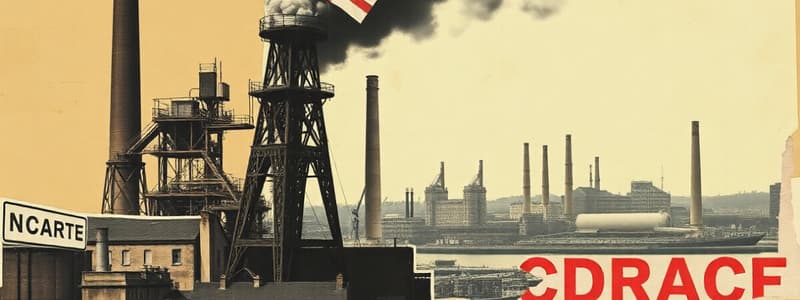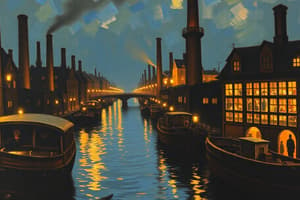Podcast
Questions and Answers
What was a significant consequence of the Industrial Revolution that affected public health?
What was a significant consequence of the Industrial Revolution that affected public health?
- Increase in urban population density (correct)
- Reduction in workplace accidents
- Expansion of rural farming
- Decline in factory production
Which of the following reforms was commonly implemented to address issues arising from industrialization?
Which of the following reforms was commonly implemented to address issues arising from industrialization?
- Child labor laws (correct)
- Cuts to education funding
- Increase in work hours
- Expansion of colonial territories
What distinguishes new imperialism from old imperialism?
What distinguishes new imperialism from old imperialism?
- Use of military force exclusively
- Rejection of trade agreements
- Focus on territorial expansion only
- Emphasis on economic control and influence (correct)
Which nation experienced a form of economic imperialism primarily affecting its political sovereignty?
Which nation experienced a form of economic imperialism primarily affecting its political sovereignty?
Which of the following best describes the similarities between Japan, Siam, and Nepal in the context of the broader Asian imperialism?
Which of the following best describes the similarities between Japan, Siam, and Nepal in the context of the broader Asian imperialism?
Flashcards
Industrial Revolution Causes
Industrial Revolution Causes
Factors that sparked the rapid growth of industries in specific periods.
Industrial Revolution Effects
Industrial Revolution Effects
Positive and negative consequences of the Industrial Revolution, on society and environment.
Economic Theories Differences
Economic Theories Differences
Comparison of distinct economic thought systems and their underlying principles.
Old vs. New Imperialism
Old vs. New Imperialism
Signup and view all the flashcards
Asian Nations' Variation
Asian Nations' Variation
Signup and view all the flashcards
Study Notes
Causes of Industrial Revolution
- Factors like abundant natural resources (coal, iron), readily available labor, technological innovations, and investment capital spurred the Industrial Revolution.
- Growing population fueled demand, increasing production needs.
- Infrastructure improvements (canals, railways) eased transportation and communication.
- Political stability fostered confidence in trade and investment.
Consequences/Effects of Industrial Revolution - good and bad
- Positive Consequences:
- Increased production and efficiency, leading to lower prices for goods.
- Technological advancements improved living standards for some.
- Rise of the middle class and new job opportunities.
- Urbanization and population growth.
- Negative Consequences:
- Poor working conditions, long hours, and low wages for factory workers.
- Environmental pollution and resource depletion.
- Social inequality and exploitation of workers.
- Urban overcrowding and spread of disease.
Health and Environmental Crises
- Health: Poor sanitation, overcrowded cities, and hazardous working conditions contributed to widespread disease.
- Environmental: Air and water pollution, deforestation, and resource depletion negatively impacted the environment.
Reforms to Address Issues of Industrialization
- Laws: Labor laws emerged to regulate working conditions, like setting minimum wages, maximum hours, and limited child labor.
- Union Reforms: Labor unions fought for workers' rights and better working conditions.
- Other Reforms: Public health initiatives improved sanitation and housing in urban areas.
Differences between Economic Theories
- Different economic theories (e.g., laissez-faire capitalism, mercantilism, socialism) emerged to explain and address the changes brought about by industrialization.
Old Imperialism vs New Imperialism
- Old Imperialism (16th-18th centuries): Driven by mercantilism, focused on establishing trading posts and outposts in Asia and Africa for raw materials and markets.
- New Imperialism (19th-20th centuries): Driven by industrialized, capitalist economies and national competition, focused on acquiring territories for direct political control and raw materials.
Economic Imperialism in Latin America
- Powerful industrialized nations exerted economic control over Latin America through investments and trade agreements.
- This often benefited the dominant nations while creating dependence and exploitation in Latin America.
Nations like Japan, Siam, and Nepal Compared to Other Asian Nations
- These nations employed a multifaceted approach to respond to the pressures from European powers:
- Adopting selective aspects of Western technology and institutions.
- Maintaining traditional cultural elements and values.
- Navigating the delicate balance between adopting modernization and preserving cultural identity.
- Differing in their degree of resistance, adaptation, and collaboration with external forces.
- Specific distinctions would be necessary to describe each case in more detail.
Analyzing Primary Sources
- Evaluating primary sources (poems, political cartoons, government documents) allows for a deeper understanding of the era's perspectives, values, and experiences.
- Such analyses often reveal differing opinions on policies, economic structures, social issues, and international relations in the historical period.
Studying That Suits You
Use AI to generate personalized quizzes and flashcards to suit your learning preferences.
Description
Explore the key factors that led to the Industrial Revolution, including natural resources, labor availability, and technological innovations. Understand the positive and negative consequences that shaped society, from increased production to poor working conditions. This quiz will test your knowledge on this transformative period in history.





